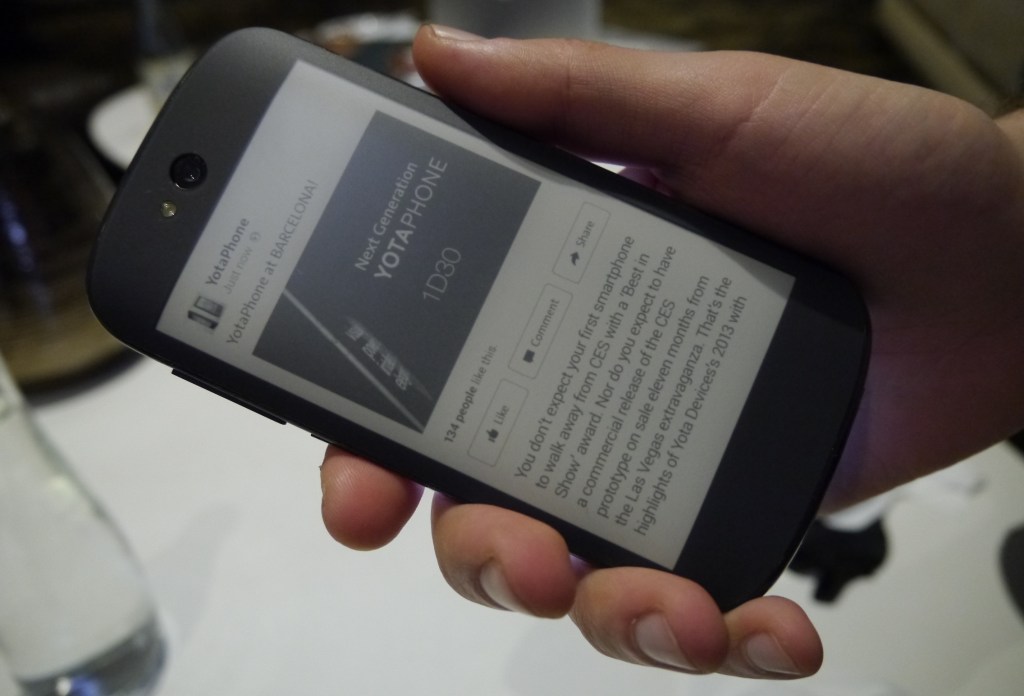
Russian mobile-making startup Yota Devices has just unveiled the next generation of its dual-screen smartphone, the YotaPhone.
As with the current first-gen model, which went on sale in Russia and select European markets (Austria, France, Spain and Germany) last December costing €499/$684, the handset’s flagship feature is that it’s two-sided — with a full colour touchscreen display on the front and a low-power consuming e-ink display on the rear.
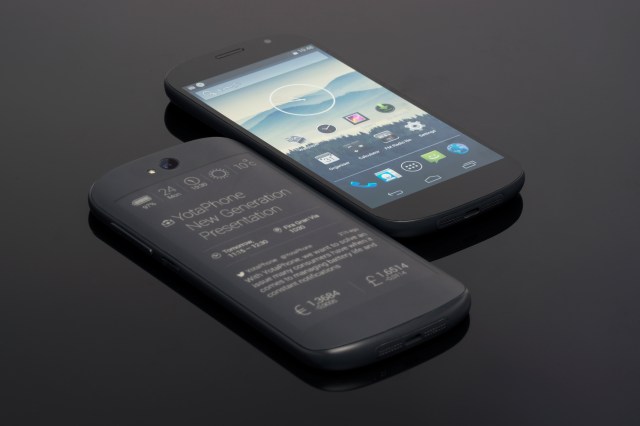
The next generation YotaPhone, as it’s currently known, won’t go on sale until the end of this year but the company showed TechCrunch a working prototype of the device, ahead of the Mobile World Congress conference kicking off today in Barcelona.
It’s also released a full specs sheet — flagging up the forthcoming processor improvements, from gen-one’s dual-core to quad-core; a larger full HD display and a larger, curved e-ink pane; a beefier battery; and more. Full details below.

But the flagship upgrade is to the capability and utility of the e-ink screen — which is now a full touch panel, with support for poking and prodding anywhere, instead of requiring users to interact only via a small touch-sensitive pane below the screen (as with the 1st-gen device).
This means users of the next-gen YotaPhone will be able to interact directly with content displayed on the e-ink screen, including, for example, responding to messages, calls and notifications, or even using it for playing thoughtful, slower-paced games like chess and sudoku.
Another use-case for YotaPhone’s EPD (electronic paper display) is to act as a dashboard for displaying customised metrics — such as your sports’ team’s latest scores, or even to display quantified health info fed in from various wearable devices. Or that’s the vision anyway — if enough developers can be inspired to build for a second screen ecosystem.
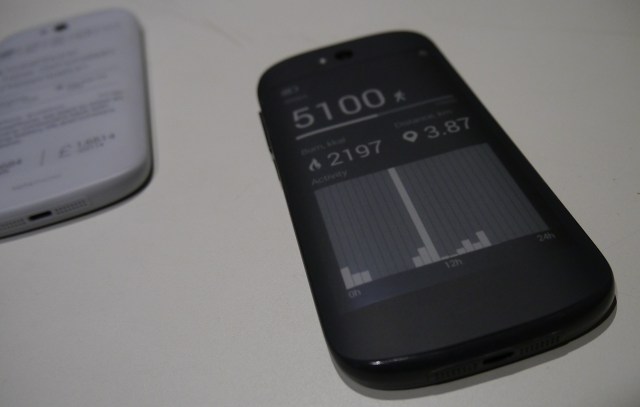
(There are currently around a dozen rear-screen apps for the first gen YotaPhone — although of course, the handset is a fully fledged Android smartphone too, with Google Play on tap.)
“The [full-touch second display] brings the YotaPhone concept to a completely new level,” said CEO Vladislav Martynov, in an interview with TechCrunch. “Now you can not only get the information you need and see it but you can interact with one touch, and you can respond to messages. Or email. Or you can accept a meeting invitation.
“The whole user experience with the backside of the phone becomes much better – this is full touch so you can swipe, you can up and down, it’s basically much more intuitive.”
The device’s price-tag has not been revealed yet but Martynov said it will be “comparable” or 10-15% lower than premium Android smartphones from the likes of Samsung, HTC and Sony that are on the market at the time it launches.
Yota Devices is aiming for the next-gen device to come to 20 markets in EMEA by the end of 2014, and is also working on versions of the device for the U.S. market and for China, also by the end of 2014 or for the beginning of 2015.
The startup will continue its strategy of selling the handset directly online — but Martynov said it may look to work with carriers in markets such as the U.S. where the handset retail market is dominated by carriers and carrier subsidies.
Owners of the existing YotaPhone will be offered a substantial discount via a trade-in program for upgrading when the next-gen model hits shelves, according to Martynov. He said they will also be first in line to get their hands on the handset.
Why add an e-ink screen to a smartphone?
What’s the point of a smartphone having a secondary, less colourful, less reactive screen if it has a perfectly good HD AMOLED pane winking at you from its shiny front? Why would a user even bother turning it round to use a monochrome EPD display?
Martynov said the key advantage of the YotaPhone concept is that the handset has an always on display that does not destroy the device’s battery life. He argues that a display with visible information constantly pumped to it has the ability to change usage behaviour, by no longer requiring smartphone users constantly wake and unlock their phone just to check in on social feeds or other key content.
In other words: it can solve the FOMO problem.
“With all this information behind a dark screen you need to wake the phone up, you need to remember about this actually — to check — and even if there are some notifications and reminders they just pop up for a few seconds and you can miss it,” said Martynov.
“The YotaPhone frees people from the fear of missing something important which is behind the dark screen. And also remove bad habits where you wake up the phone 150 times a day just for no reason — just to check what is there, in Twitter and Facebook etc… Snubbing people around yourself in favour of your smartphone becomes quite a bad habit.”
Arguably Yota Devices is creating a new category of device here — one which rolls the functionality of a notifications’ focused wearable, such as Pebble’s smartwatch, right into the smartphone form factor – without the need for the user to carry and charge up two separate devices after all. And that’s a very neat idea indeed. Two functions, in the same handset.
Look around you at the smartphones people are using everyday and it’s pretty plain that current handset hardware has been commoditized, with makers converging along similar form factor lines, churning out touchscreen slabs that focus on maximizing the available screen area and minimizing everything else.
Slightly bigger screens — and the rise of a phablet category — is the most notable form factor evolution of recent years (along with the death of physical Qwertys). So it’s easy to assume that single-sided touch-sensitive slabs are the end of the road for handset hardware evolution in the near term — an unchanging constant for years to come.
Well, Yota Devices wants to change the perception that a single screen that spends a large portion of its life asleep and unlit, displaying zero information, is the end of the road for smartphone hardware evolution. It’s on a mission to prove that two screens can indeed be better than one.
The original two-faced YotaPhone concept (pictured below) was unveiled all the way back in December 2012. That first gen device had a 4.3-inch LCD touchscreen display on the front, augmented by a 4.3-inch e-ink display on its rear — allowing for content to be sent from the primary screen to the back pane for easier-on-the-eyes e-ink reading.

Other uses for the back screen that were flagged up at the time included customisation of the look of the phone (by, for instance, displaying photos/wallpapers on the back), as well as offering device utility even after the phone’s battery had died, e.g. by still being able to display content such as a map or mobile boarding pass on the back.
The disruptive advantage of e-ink is its very low power consumption — meaning it’s possible to build a dual-screen smartphone that can still deliver a day’s use without requiring a charge. Battery life of the next-gen YotaPhone is much much longer if you only opt to read content via its e-ink pane (circa 58-68 hours).
The device will also have a Smart Power Mode that can enabled which turns off the colour display entirely but still allows the user to perform basic functions via the e-ink screen — such as making calls and sending texts.
“By doing this you really save the battery,” said Martynov. “It’s one feature of YotaPhone that’s quite relevant for people who like hiking, or for tourists walking around a lot, or people who forget their charger in the morning.”
Mixed use of both screens will obviously result in less impressive battery longevity (but still likely eking out a longer useful life than the average single colour touchscreen smartphone), while heavy use of the colour screen will yield battery life that’s “comparable” with premium smartphones, according to the company.

Giving a big idea time to breathe
The first-gen YotaPhone finally went on sale at the end of 2013, a year after it was unveiled – and that long lead in time from prototype unveiling to shipping a commercial product is a conscious strategy for the handset startup, which Martynov said it intends to replicate with the next-generation YotaPhone device being announced today.
Like the two-sided YotaPhone itself, the reason is two-fold: firstly Yota Devices is relatively new to making handsets, having been spun out of parent company Yota Group in 2012, a maker of LTE hotspots and modems (sales of which part-fund development of the YotaPhone; along with private investors); and secondly because it’s building what amounts to a new category of portable — which means there’s a need to both educate users on the advantages of having a second, e-ink screen at their command, and also listen to other people’s ideas for how to make this new concept really useful.
“This is not just a smartphone. We introduced a completely new type of device where user experience is different. The biggest challenge was to educate people what is so cool about second screen?” said Martynov, discussing the length of time from the concept being unveiled to the startup shipping actual product.
“We are a small startup trying to win a certain marketshare on a market where big brands are fighting. We can’t do what they do; we need to find our own way — and I strongly believe, with this concept, if we involve broad community of developers, media, bloggers, experts in the whole development process and do a kind of product development crowdsourcing, in a sense, that’s what will make us successful,” he added.
One area where Yota Devices is relying on crowdsourcing ideas to pour into YotaPhone’s development is on the apps side. Apps are really needed to build out the utility of that second screen.
Today, it’s making its previously selective SDK public so any developers wanting to take advantage of the back-side e-ink screen can download it and start building.
Currently there are only around a dozen dedicated apps for the rear screen — including apps for reading, maps and navigation, social media/RSS, notebook/to-do list, organiser and wallpaper apps, plus YotaPhone’s own Put2Back software which allows the user to send info and images from the main screen to the e-ink screen. It’s going to need a lot more to really make its big idea shine.
Over the past two+ years, Martynov said the YotaPhone concept has been steadily nourished by outside ideas coming in from developers and others inspired by the idea, and also — over the past two months — from YotaPhone’s first batch of early adopters.
As with scores of makers taking to crowdsourcing sites like Kickstarter to build products, leaning on a community for feedback and ideas is core to the philosophy of YotaPhone’s smartphone startup — albeit, it’s not taking the direct crowdfunding approach.
“When we started YotaPhone two years ago, we had a few examples of why we’re doing this and what the applications might be but during the whole development process, since we unveiled this information, we’ve got tonnes of new ideas and proposals from the community. And we integrated and implemented quite a lot of them in the final commercial product,” he said, adding: “I strongly believe the future of any product development in high tech and devices business and software, any applications, will be crowdsourced.”
First prove the concept, then scale
How many first-gen YotaPhones have been sold so far? Martynov is not currently breaking out a figure, saying it’s too early days. But presumably the sales of the first device haven’t been huge, considering it such a nascent, recently launched leftfield product with limited market release.
“We never target big volumes,” he says, when asked about sales figures. “Because it would be quite naive for a 2.5-year-old company [making] a quite unique smartphone to really hit the big volumes. It would be wrong strategy to do so.”
Martynov says the first-gen device is really about proving the concept — to industry, to early buyers, and to Yota’s own investors. The next generation YotaPhone is where things are going to get serious.
“Our shareholders and investors they believe and they provide long-term commitment to invest in a second, and a third generation of the product,” he tells TechCrunch, adding that the ultimate vision is an e-ink screen that expands to cover 100% of the back of the device, up from the circa 75% covered by the next-gen handset. Pushing the boundaries of EPD to improve its resolution and refresh rate are other aims as YotaPhone evolves.
“We have proved there is a customer demand in many countries, we have proved people love it — for example we had a moneyback guarantee program (30 days you can return back the phone) and we didn’t have a single phone returned so far. And we are already unveiling information about second generation of the phone,” he adds.
“The development of this phone is going to go full speed — it’s going to go EMEA, China and U.S. So we are getting into a new phase of our business development. We are moving from amateur into professional league, in this sense. We are building mass product with the second generation of YotaPhone. Where the first generation was more like proof of concept.”
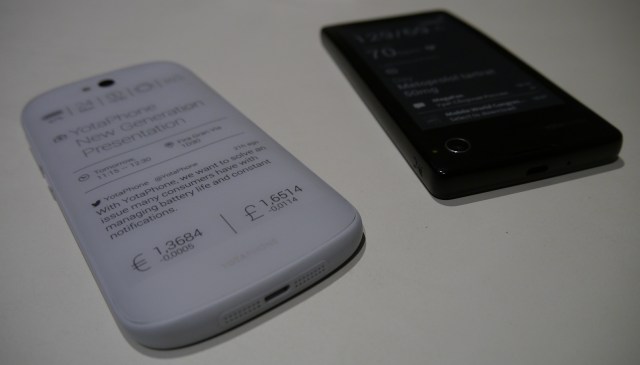
Read more : Next-Gen YotaPhone Follow-Up Unveiled, With Full-Touch E-Ink Rear Screen



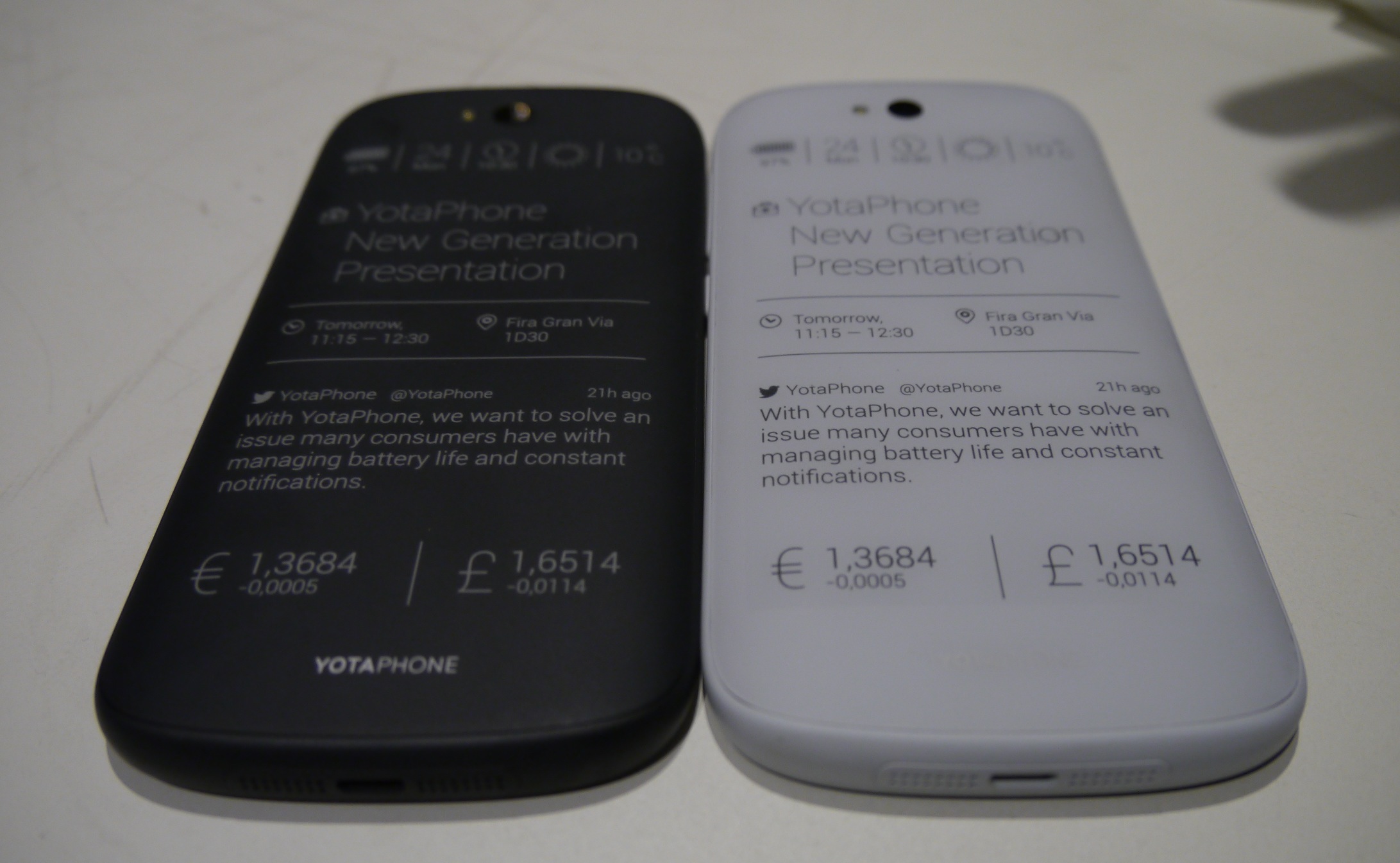







0 Responses
Stay in touch with the conversation, subscribe to the RSS feed for comments on this post.